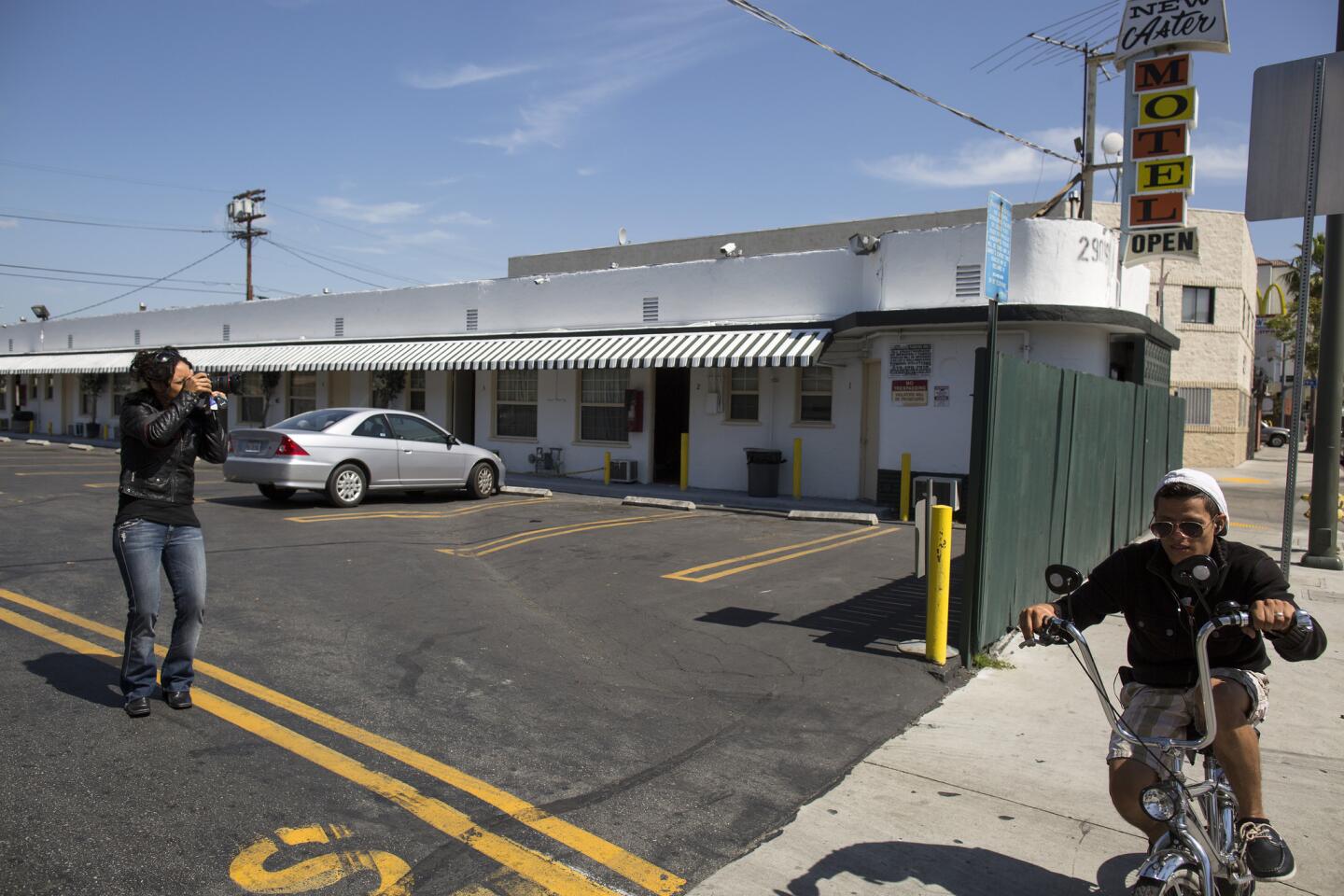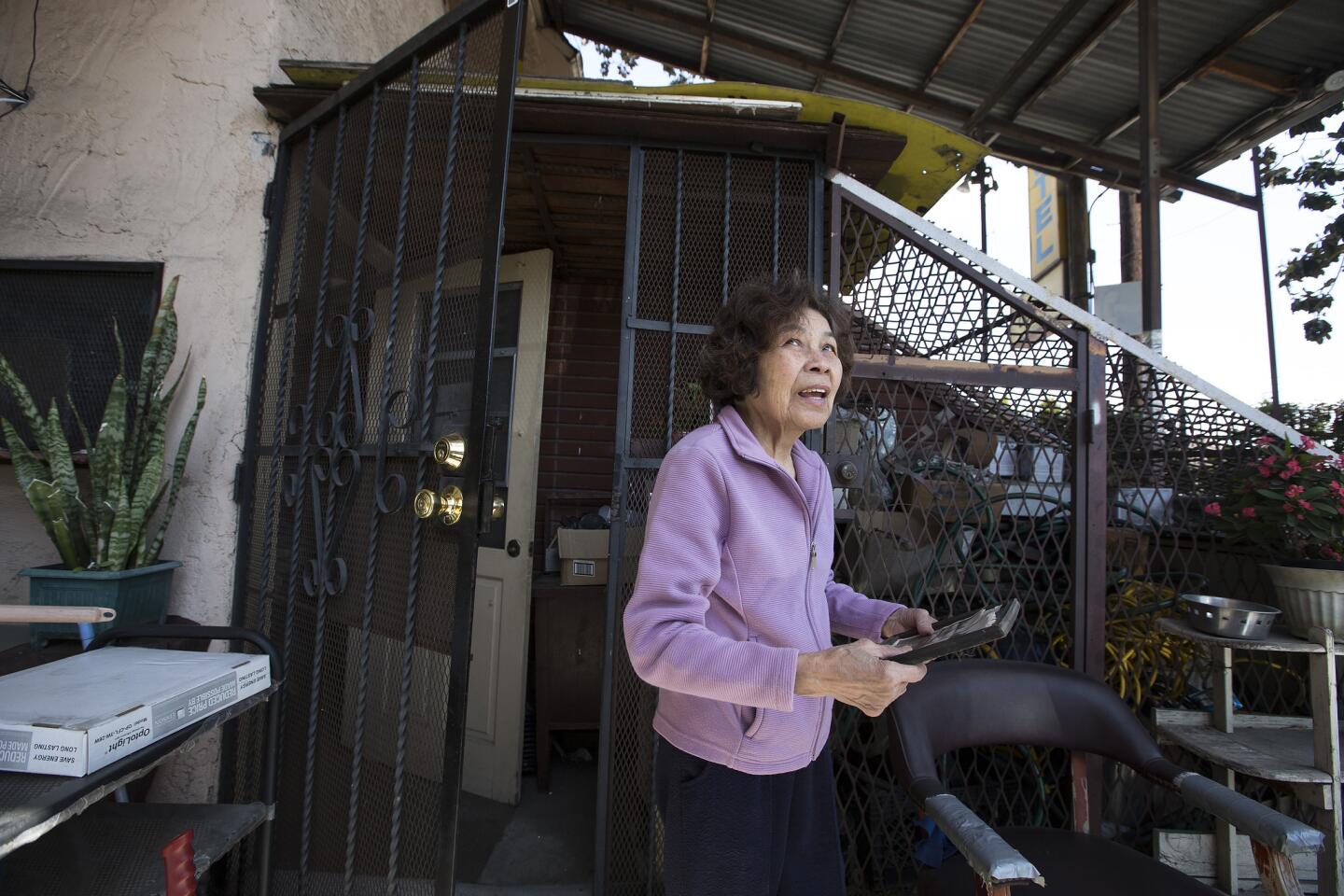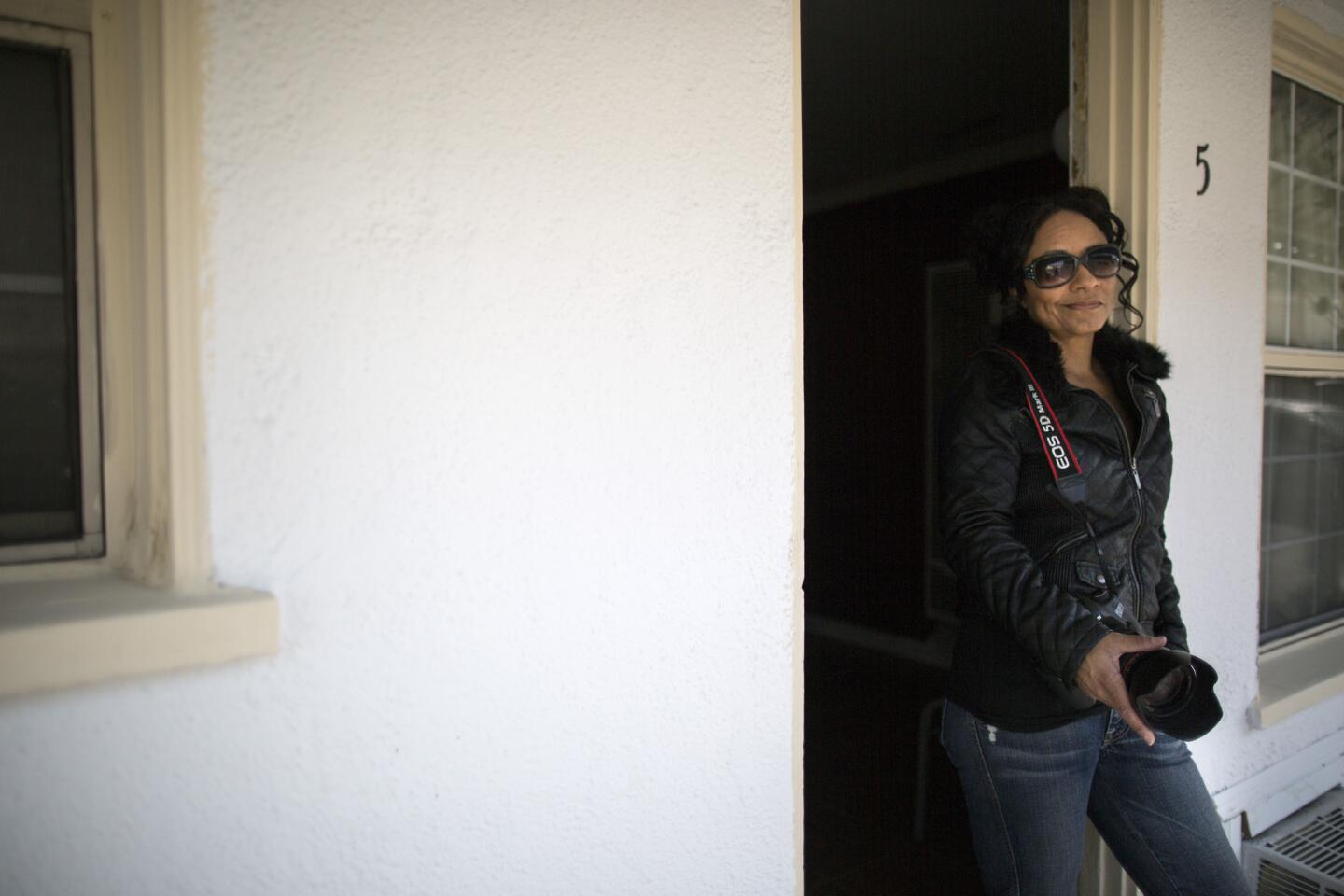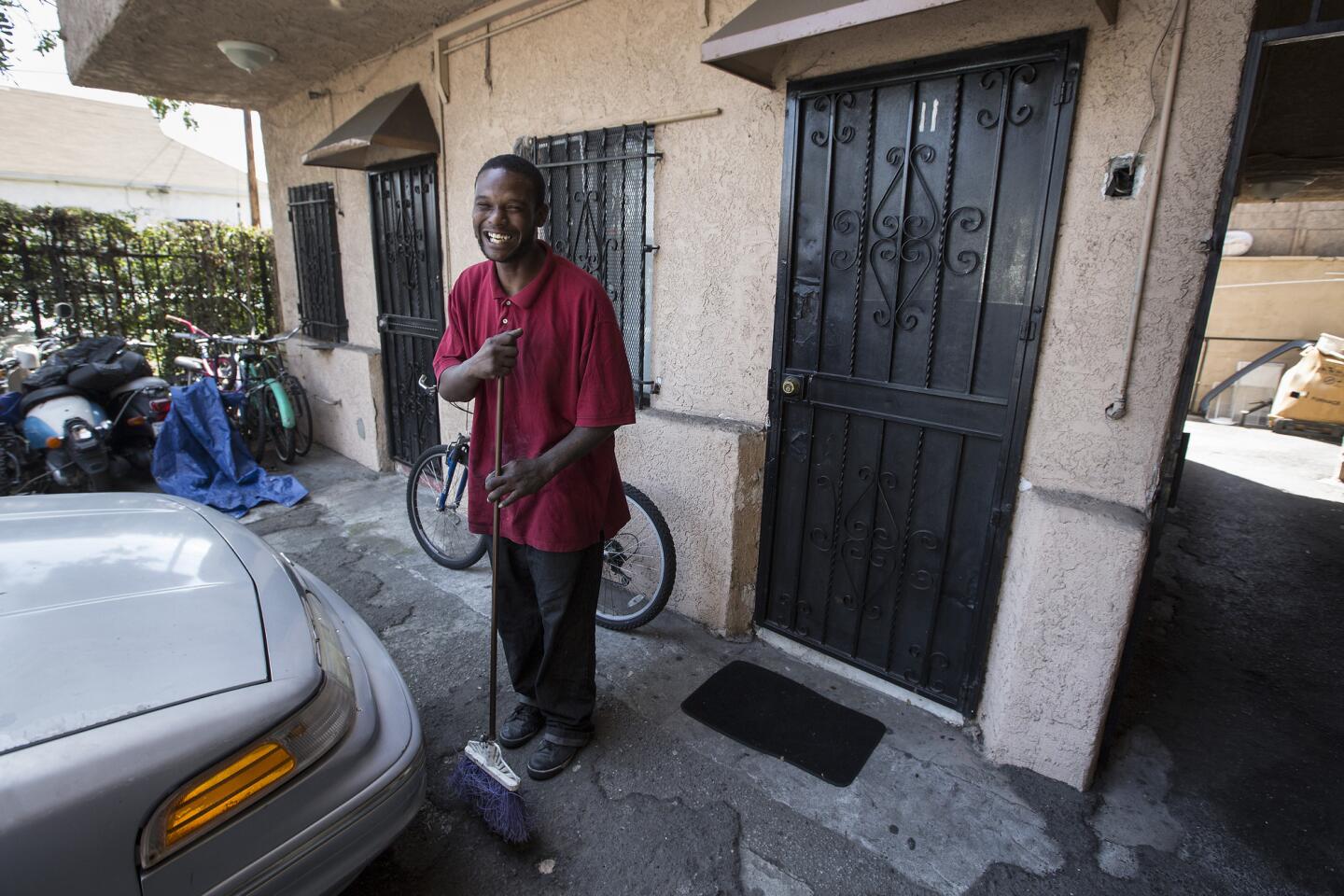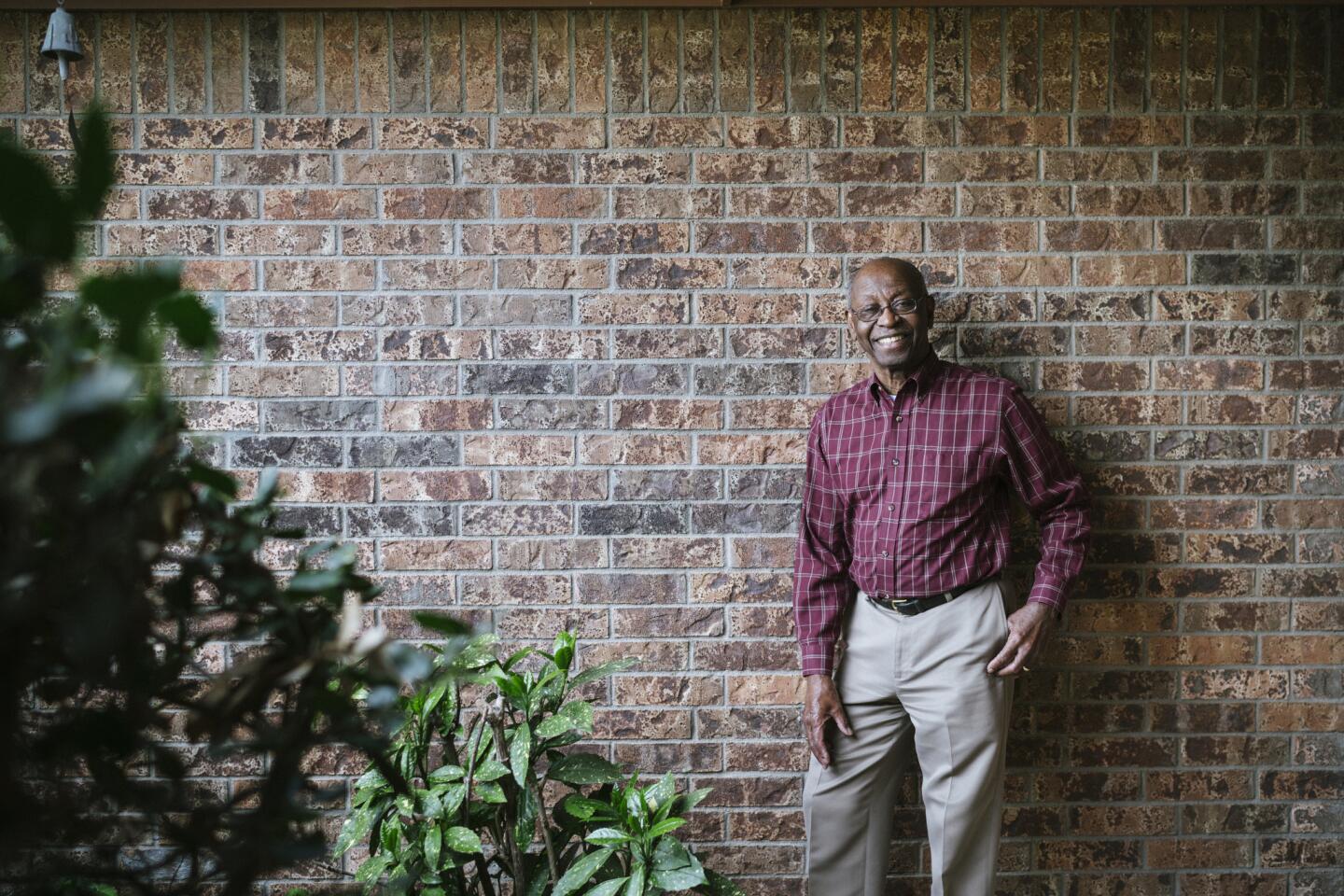This guidebook helped African Americans find a hotel along segregation-era Route 66
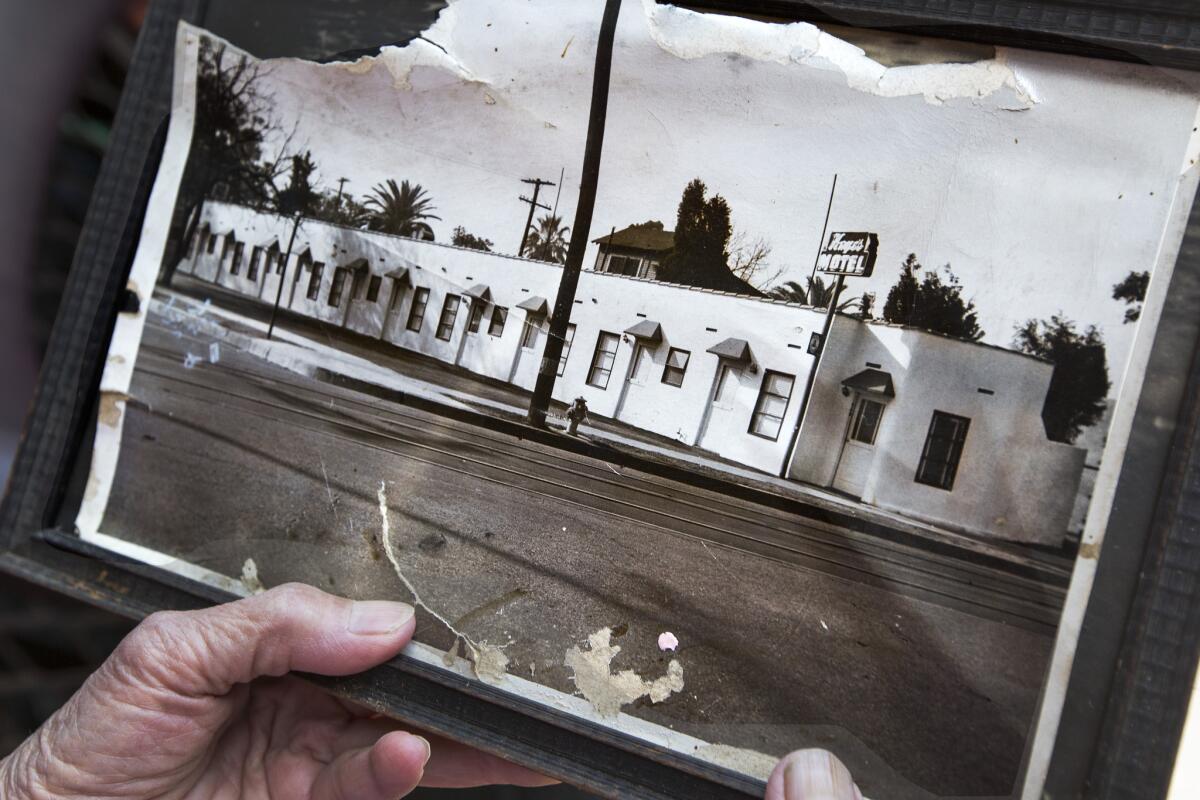
- Share via
Stepping out of a dingy motel office shielded by security bars, Lily Ho held up a faded and torn photograph. It showed the building shortly after it opened south of downtown Los Angeles in 1947.
Back then, the Hayes Motel was sleek, modern and clean.
The one Ho stood outside of this spring is a heap of peeling paint, crumbled plaster and signs that warn, “No drugs. No Prostitution. No loitering. No Trespassing.”
“The original owner was very proud of this place,” recalled Ho, 78, who now owns the motor court in a distressed neighborhood at the corner of Wadsworth Avenue and Jefferson Boulevard.
The Hayes might not be much to look at today, but it’s considered such a valuable element of Los Angeles history that it is being listed in an inventory of structures significant to the city’s past.
In particular, the Hayes was a refuge for African American travelers who made their way west on the legendary cross-country highway U.S. Route 66, guided by a rich and illuminating travel publication known as the Negro Motorist Green Book. The motel was among 224 Los Angeles hotels, barbershops, beauty salons, taverns, motels and other places the guide deemed friendly to blacks traveling America’s highways.
The inventory, led by Los Angeles officials in collaboration with the Getty Conservation Institute, will help lay the groundwork for rehabilitation and protection of significant historic structures. Some, including Green Book destinations still standing, could be designated as L.A. Historic-Cultural Monuments.
“At the very least, these sites can be incorporated into our city’s online inventory system,” said Ken Bernstein, principal planner for the Los Angeles Department of City Planning’s Office of Historic Resources. “They are part of the story of African Americans in Los Angeles, and the story of Los Angeles itself writ large.”
They are part of the story of African Americans in Los Angeles, and the story of Los Angeles itself writ large.
— Ken Bernstein
The Green Book was created by Victor H. Green, a postal service worker from Harlem, N.Y., who began publishing the guide in 1936 to help African Americans avoid, as he put it, “embarrassing moments” after motorists started exploring long-distance roadways including Route 66, the nation’s first transcontinental highway.
Most of the 224 Los Angeles sites have been razed or put to other uses. But 56 survivors include landmarks such as the Biltmore Hotel, Clifton’s Cafeteria and the Dunbar Hotel, where famous figures such as Lena Horne, Joe Louis, Duke Ellington, Louis Armstrong and others would stay when they visited the city because white hotels would not house them.
There were also dozens of lesser known welcoming locales, including the Hayes, the Aster Motel and a modest wood-framed house in the 1200 block of South New Hampshire Street listed in the guide as the residence of “Mrs. J. O. Banks.”
Today, Green’s rare paperbacks are more than just evidence of the hazards of travel faced by African Americans in Los Angeles before the passage of the Civil Rights Act in 1964.
In an age of social media and 21st century racial justice movements such as Black Lives Matter, scholars and federal historians are using Green Books as guides to research locales across the nation as part of an effort to better understand the African American experience, and build a national park system that better reflects the diversity of America’s history, people and culture.

WATCH: Richard L. Mitchell talks about the dangers faced by African Americans travelers in the days of segregation and how the “Green Book” led to safe havens along Route 66.
The world’s largest collection of Green Books is archived at New York City Library’s Schomburg Center for Research in Black Culture: 23 issues published between 1937 and 1966, when the travel guide folded. High definition images of the books are offered on a center website.
A year ago, a copy of a 1941 edition of the Green Book sold at auction for $22,000 to the Smithsonian Institution.
“It’s almost a miracle that there is such a diverse physical legacy of Green Book properties,” said Frank Norris, a historian with the National Park Service’s National Trails office, which oversees the Route 66 Corridor Preservation Program. “I expect to see a number of these structures nominated to the National Register of Historic Places.”
They stand as reminders of a little-known African American history of the American road trip.
Green created his travel guide, in part, because he knew there would be trouble ahead for African Americans after Route 66 was designated in 1926.
Stretching 2,448 miles from Chicago to Los Angeles, Route 66 passed through three time zones, eight states, 89 counties and dozens of “sundown towns” that enforced segregation with local laws, intimidation and violence.
The prevailing direction of traffic along Route 66 was east to west: over Midwest wheat prairies, the Mississippi River, Missouri’s Ozark Mountains and the Texas Panhandle, across the New Mexico and Arizona deserts, over the Colorado River and west to Southern California’s sparkling beaches, movie industry, fragrant orange blossoms and jobs.
It was the path of the dispossessed who fled Oklahoma’s Dust Bowl in Steinbeck’s 1939 novel, “The Grapes of Wrath,” and a ribbon of olive green for convoys of troops headed for desert training camps in the 1940s with Gen. George S. Patton.
Route 66 spawned a popular television series, and two generations of musicians from Nat King Cole to the Rolling Stones recorded the song “Route 66,” making it a part of America’s musical lexicon:
Won’t you get hip to this timely tip.
When you make that California trip
Get your kicks on Route 66.
Richard Mitchell paid less than a buck for the Green Book he ordered by U.S. Mail after noticing an advertisement for one in a 1963 edition of Ebony Magazine. He was nearing the end of his tour of duty as an Air Force cryptographer stationed in Turkey at the time and planning a road trip with his wife and two young children.
“We left home in Pennsylvania in a two-tone green 1960 Dodge Dart station wagon,” recalled Mitchell, 84, of Albuquerque, N.M. “I timed my travel to make sure that we would roll into a safe place to stay by night,” he said.
“We only had one problem along the way,” he said. “A bunch of young folks” hurled a racial epithet at a hamburger stand.
Out in the Los Angeles area, African Americans couldn’t buy a home in so-called red-lined neighborhoods. Some street corners had signs on 6-foot poles that said, “No Negroes or Orientals Desired.” In movie theaters, African Americans sat on one side of a velvet rope and whites on the other. Some department stores handed African American women pieces of tissue paper before they tried on hats.
In 1985, Route 66 was decommissioned. It had been replaced by superhighways that bypassed the stucco wigwams, motor courts and greasy spoons with flashing “EAT” signs that helped introduce millions of mostly white Americans to the wonders of the western United States.
Armed with a Canon 5D Mark III camera, Candacy Taylor has been documenting aspects of long-distance travel with images that can only be seen from the vantage points of Green Book sites.
------------
FOR THE RECORD
10:07 a.m.: An earlier version of this article misspelled the name of the Canon 5D Mark III camera as Cannon.
------------
“The Green Book is an uplifting and powerful example of black people standing up and finding a practical and innovative solution to a horrific problem,” said Taylor, 45, a documentarian and expert on the Green Book and its legacy. “We have a lot to learn from it.”
The payoff is in multimedia productions including a video she recently produced for the National Park Service that reveals what it may have felt like to venture out on desolate two-lane highways at a time when racial discrimination was in full swing.
On a recent weekday, Taylor explored the Hayes Motel, which she described as “an example of a heartbreaking paradox I discovered in my research.”
“Many Green Book sites once regarded as safe havens for African Americans are now clustered in poverty-stricken neighborhoods where African American lives are at risk.” she said. “Unless something is done soon, the Green Book’s trove of surviving properties will be lost due to gentrification and neglect.”
See more of our top stories on Facebook >>
ALSO
A transgender 9-year-old tells her story
More to Read
Sign up for Essential California
The most important California stories and recommendations in your inbox every morning.
You may occasionally receive promotional content from the Los Angeles Times.
